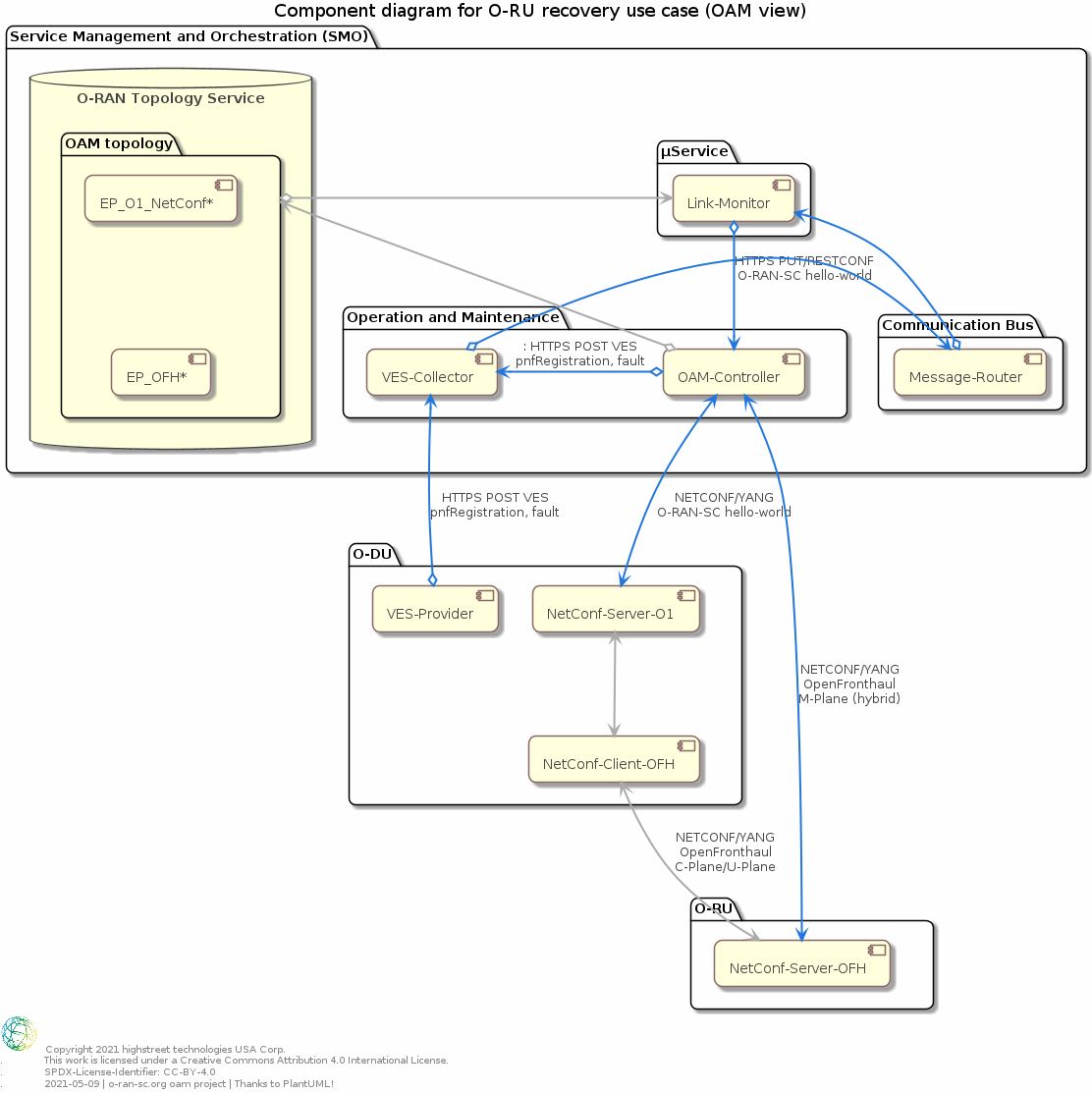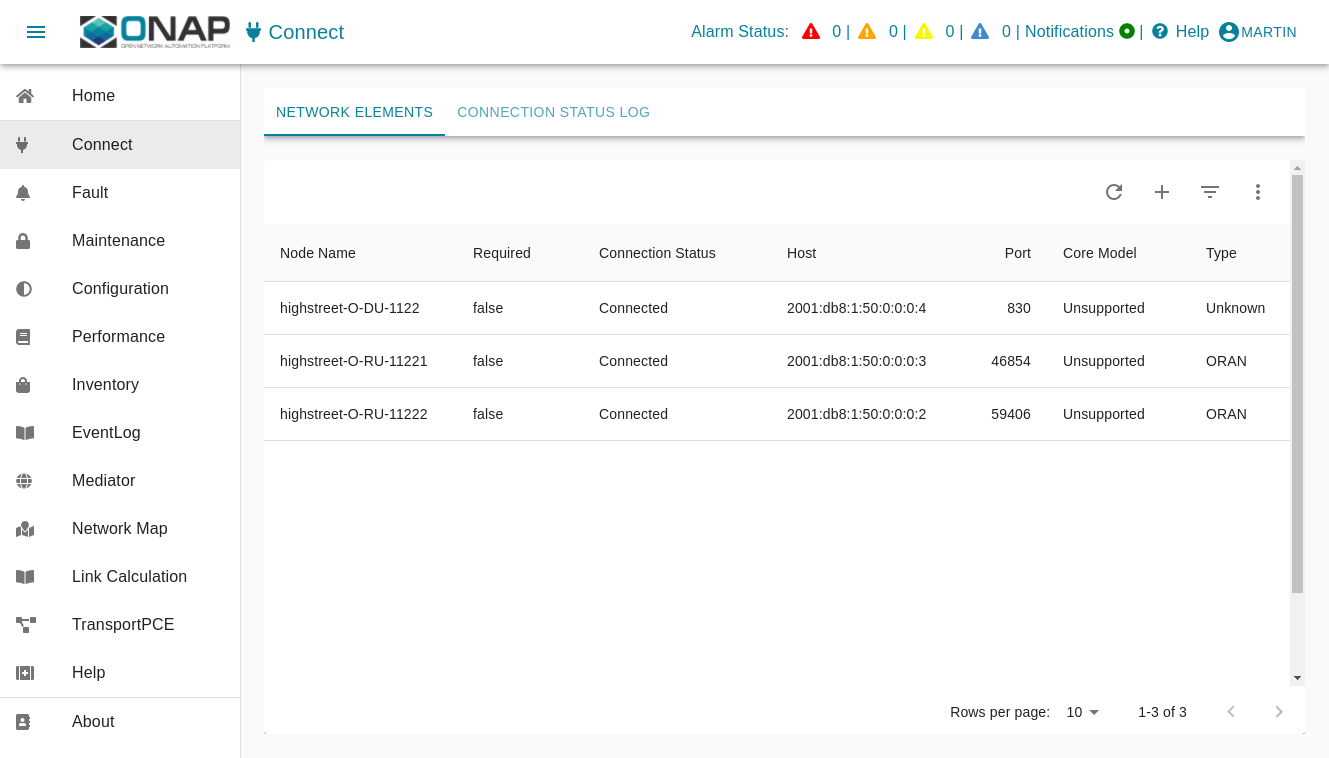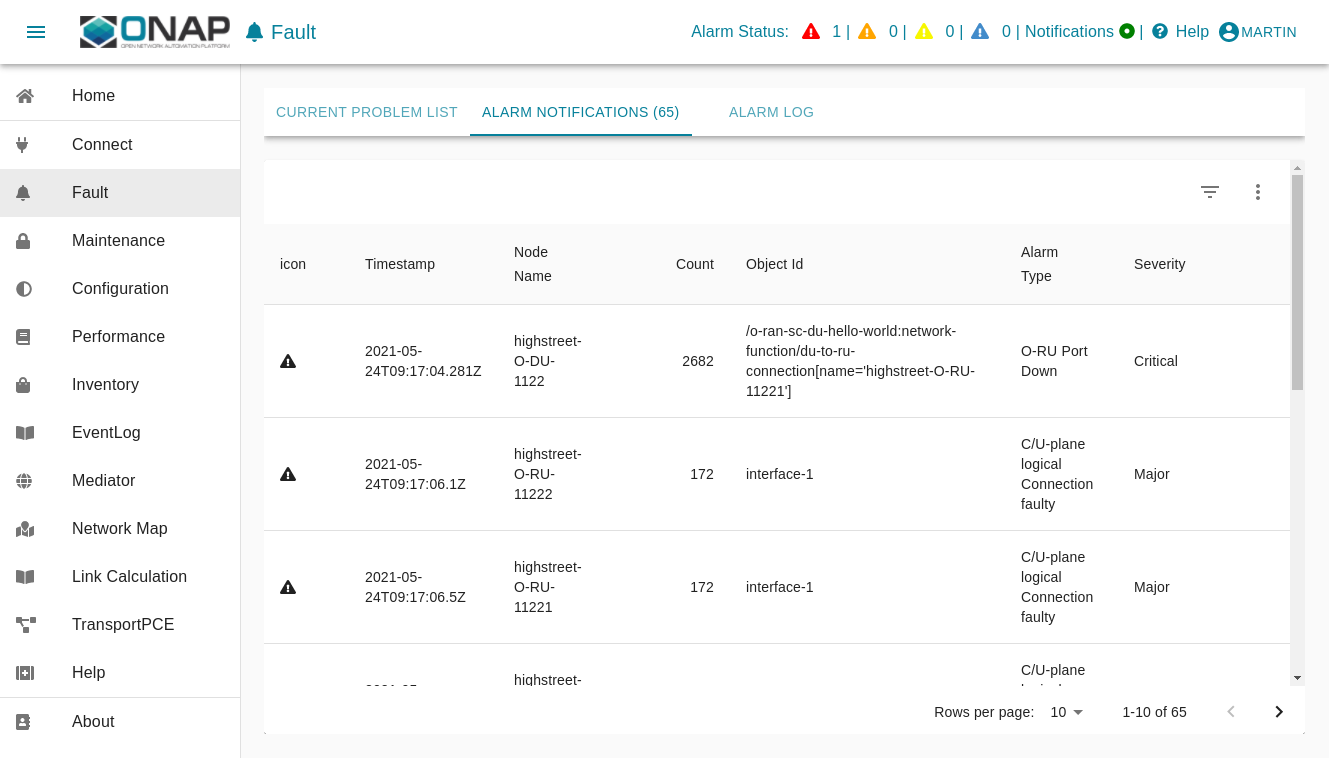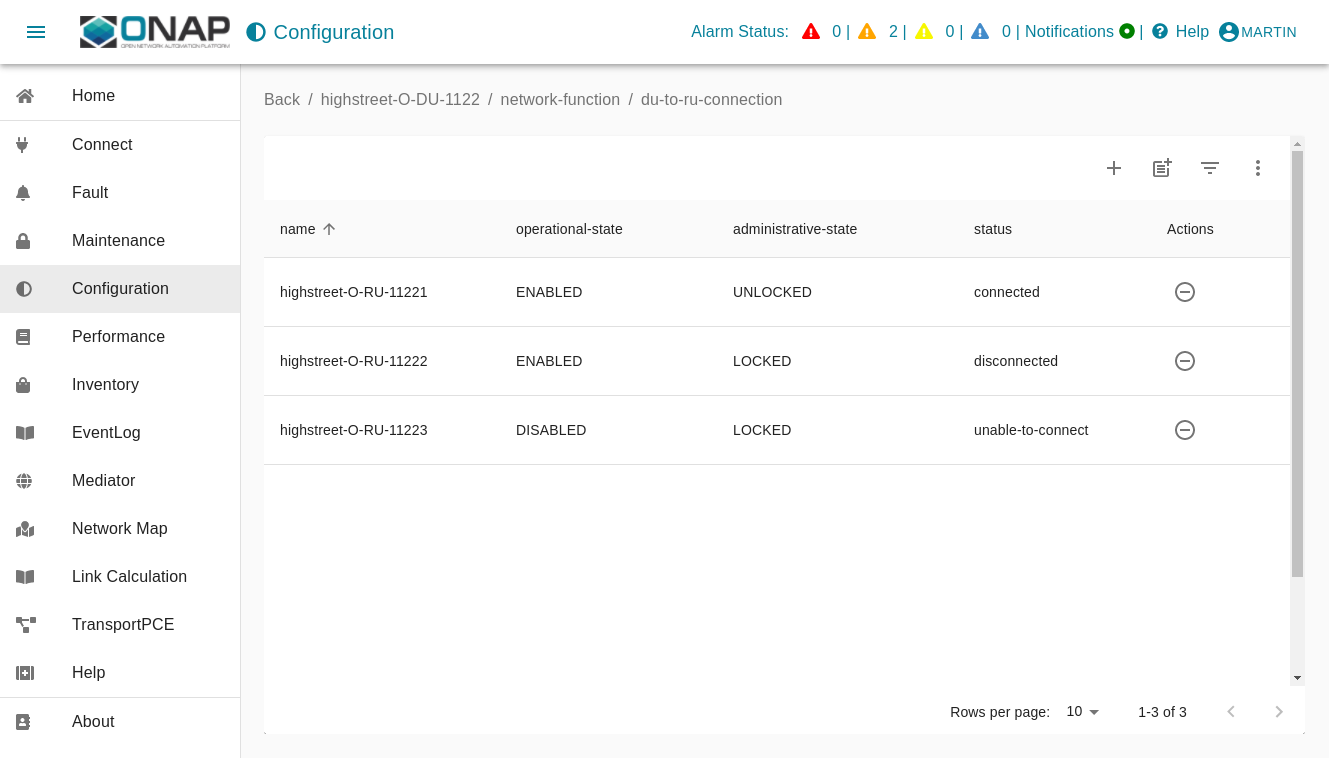- Created by Martin Skorupski, last modified by 秀吉 蔡 on Aug 31, 2023
Table of Contents
Sub pages
Scope
This wiki describes the test environment for OAM specific test cases focusing on D-Release Closed Loop O-RU recovery use case.
OAM-193 - Getting issue details... STATUS
Components
The following Component diagram shows the most relevant components and their associations from O-RAN-SC OAM project point of view.
The different software components can be deployed with Docker-Compose or Kubernetes technologies.
As O-RAN Alliance targets IPv6 please ensure the Docker IPv6 functionality is enabled (see O-RAN-SC Documentation Docker: Enable IPv6) or use Kubernetes version 1.19 or higher.
Diagram

Please see Closed loop use case
Descriptions
O-RU - NETCONF-Server-OFH
For D-Release the O-RU operates in "hybrid" mode. This means that the O-RU exposes O-RAN OpenFronthaul NETCONF/YANG interface directly to the OAM functions of the SMO.
For OAM test environment it is recommended to use the O-RU FH simulation from O-RAN-SC Sim project. The docker imager can be loaded directly from O-RAN-SC Nexus (nexus3.o-ran-sc.org:10004/o-ran-sc/nts-ng-o-ran-ru-fh:1.3.0).
The simulation must be configured in a way that is support NETCONF call-home to the SMO-OAM-Controller and supports NETCONF <create-subscriptions/> RPC for stream "NETCONF".
The simulation must not expose any VES messages.
Depending on the OAM controller capabilities TLS certs of the O-RU must be configured at the OAM-Controller.
The following protocols from O-RU to OAM controller are under test:
- NETCONF-Callhome/SSH/IPv4
- NETCONF-Callhome/TLS/IPv4
- NETCONF-Callhome/SSH/IPv6
- NETCONF-Callhome/TLS/IPv6
- NETCONF/SSH/IPV4 for all NETCONF operations (but mainly GET, GET-CONFIG, EDIT-CONFIG)
- NETCONF/TLS/IPv4 for all NETCONF operations (but mainly GET, GET-CONFIG, EDIT-CONFIG)
- NETCONF/SSH/IPV6 for all NETCONF operations (but mainly GET, GET-CONFIG, EDIT-CONFIG)
- NETCONF/TLS/IPv6 for all NETCONF operations (but mainly GET, GET-CONFIG, EDIT-CONFIG)
O-DU - NETCONF-Server-O1
For D-Release the O-DU operates in "hybrid" mode. This means that the O-DU does not expose any management plane functions of connected O-RUs. To reduce the development effort on O-DU it was decided in RSAC meetings that the O-DU at minimum exposes the o-ran-sc-hello-world.yang (see OAM-169 - Getting issue details... STATUS and ODUHIGH-322 - Getting issue details... STATUS ).
For OAM test environment it is recommended to use the O-DU O1 simulation from O-RAN-SC Sim project. The docker imager can be loaded directly from O-RAN-SC Nexus (nexus3.o-ran-sc.org:10004/o-ran-sc/nts-ng-o-ran-du:1.3.0).
The simulation must be configured in a way that is support NETCONF for configuration management only and VES for heartbeat, fault and pnfRegistration.
Depending on the OAM controller capabilities TLS certs of the O-DU must be configured at the OAM-Controller.
The following protocols from O-RU to OAM controller are under test:
- VES:pnfRegistration https/IPv4
- VES:heartbeat https/IPv4
- VES:fault https/IPv4
- VES:pnfRegistration https/IPv6
- VES:heartbeat https/IPv6
- VES:fault https/IPv6
- NETCONF/SSH/IPV4 for all NETCONF operations (but mainly GET, GET-CONFIG, EDIT-CONFIG)
- NETCONF/TLS/IPv4 for all NETCONF operations (but mainly GET, GET-CONFIG, EDIT-CONFIG)
- NETCONF/SSH/IPV6 for all NETCONF operations (but mainly GET, GET-CONFIG, EDIT-CONFIG)
- NETCONF/TLS/IPv6 for all NETCONF operations (but mainly GET, GET-CONFIG, EDIT-CONFIG)
OAM Controller
For D-Release the OAM controller provides a NETCONF client for SSH and/or TLS, a RESCONF server, and providers and listeners to the message router.
For OAM test environment it is recommended to use the ONAP CCSDK/SDNC/SDN-R in combination with KeyCloak as centralized user management. The docker imager can be loaded directly from ONAP Nexus (nexus3.onap.org:10001/onap/sdnc-image:2.1.5) and from KeyCloak (quay.io/keycloak/keycloak:12.0.4)
The new functionalities for D-Release are:
- to convert NETCONF call-home into VES:pnfRegistration (JIRA | CCSDK-3160)
- to convert NETCONF notification by O-RU/alarm-notify into VES:fault (JIRA | CCSDK-3158)
- Gui-Cut-Through for O-RUs
The following test cases should be performed using a centralized user management based on KeyCloak.
- O-RU/NETCONF-Callhome/SSH/IPv4 → VES:pnfRegistration to message router
- O-RU/NETCONF-Callhome/TLS/IPv4 → VES:pnfRegistration to message router
- O-RU/NETCONF-Callhome/SSH/IPv6 → VES:pnfRegistration to message router
- O-RU/NETCONF-Callhome/TLS/IPv6 → VES:pnfRegistration to message router
- O-RU/NETCONF-Notification/SSH/IPv4/alarm-notifiy → VES:fault to message router
- O-RU/NETCONF-Notification/TLS/IPv4/alarm-notifiy → VES:fault to message router
- O-RU/NETCONF-Notification/SSH/IPv6/alarm-notifiy → VES:fault to message router
- O-RU/NETCONF-Notification/TSL/IPv6/alarm-notifiy → VES:fault to message router
- VES:pnfRegistration from message router → O-DU/NETCONF/SSH/IPv4/<hello/>
- VES:pnfRegistration from message router → O-DU/NETCONF/TLS/IPv4/<hello/>
- VES:pnfRegistration from message router → O-DU/NETCONF/SSH/IPv6/<hello/>
- VES:pnfRegistration from message router → O-DU/NETCONF/TSL/IPv6/<hello/>
- RESTCONF/HTTPS-GET/RESTCONF/IPv4 → O-DU/NETCONF/SSH/IPv4/<get-config/>/hello-world.yang
- RESTCONF/HTTPS-GET/RESTCONF/IPv4 → O-DU/NETCONF/TLS/IPv4/<get-config/>/hello-world.yang
- RESTCONF/HTTPS-GET/RESTCONF/IPv4 → O-DU/NETCONF/SSH/IPv6/<get-config/>/hello-world.yang
- RESTCONF/HTTPS-GET/RESTCONF/IPv4 → O-DU/NETCONF/TLS/IPv6/<get-config/>/hello-world.yang
- RESTCONF/HTTPS-GET/RESTCONF/IPv6 → O-DU/NETCONF/SSH/IPv4/<get-config/>/hello-world.yang
- RESTCONF/HTTPS-GET/RESTCONF/IPv6 → O-DU/NETCONF/TLS/IPv4/<get-config/>/hello-world.yang
- RESTCONF/HTTPS-GET/RESTCONF/IPv6 → O-DU/NETCONF/SSH/IPv6/<get-config/>/hello-world.yang
- RESTCONF/HTTPS-GET/RESTCONF/IPv6 → O-DU/NETCONF/TLS/IPv6/<get-config/>/hello-world.yang
- RESTCONF/HTTPS-PUT/RESTCONF/IPv4 → O-DU/NETCONF/SSH/IPv4/<get-config/>/hello-world.yang
- RESTCONF/HTTPS-PUT/RESTCONF/IPv4 → O-DU/NETCONF/TLS/IPv4/<get-config/>/hello-world.yang
- RESTCONF/HTTPS-PUT/RESTCONF/IPv4 → O-DU/NETCONF/SSH/IPv6/<get-config/>/hello-world.yang
- RESTCONF/HTTPS-PUT/RESTCONF/IPv4 → O-DU/NETCONF/TLS/IPv6/<get-config/>/hello-world.yang
- RESTCONF/HTTPS-PUT/RESTCONF/IPv6 → O-DU/NETCONF/SSH/IPv4/<get-config/>/hello-world.yang
- RESTCONF/HTTPS-PUT/RESTCONF/IPv6 → O-DU/NETCONF/TLS/IPv4/<get-config/>/hello-world.yang
- RESTCONF/HTTPS-PUT/RESTCONF/IPv6 → O-DU/NETCONF/SSH/IPv6/<get-config/>/hello-world.yang
- RESTCONF/HTTPS-PUT/RESTCONF/IPv6 → O-DU/NETCONF/TLS/IPv6/<get-config/>/hello-world.yang
- Gui-Cut-Through to O-RUs
VES Collector
There are no new functions required for the VES Collector. The regression tests are covered by test cases mentioned above.
For OAM test environment it is recommended to use the ONAP DCAE VES-Collector. The docker imager can be loaded directly from ONAP Nexus (nexus3.onap.org:10001/onap/org.onap.dcaegen2.collectors.ves.vescollector:1.8.0).
Message Router
There are no new functions required for the Message Router. The regression tests are covered by test cases mentioned above.
For OAM test environment it is recommended to use the ONAP DMaaP. The docker imager can be loaded directly from ONAP Nexus (nexus3.onap.org:10001/onap/dmaap/dmaap-mr:1.1.18).
For manual checks of activities on the Message Router a REST client is recommended (e.g. PostMan, vsCode with REST-client extension, Browser-RestClient-extensions, ....)
Test Networks
it is recommended to run the different components in different networks for security and responsibility reasons.
DMZ
DMZ (demilitarized zone) contains and exposes external services to the internet (IPv4 only).
The network-id is 30 - the short name is dmz.
- IPv4
- Subnet: 172.30.0.0/16
- Gateway: 172.30.0.1
SMO
The primary network to exchange data between the physical nodes and virtual machines related to the SMO components.
The network-id is 40 - the short name is smo.
- IPv4
- Subnet: 172.40.0.0/16
- Gateway: 172.40.0.1
- IPv6
- Subnet: 2001:db8:1:40::/96
- Gateway: 2001:db8:1:40::1
OAM
The primary network for interactions between SMO and the O-RAN network (O1, OpenFronthaul-Managment-Plane).
The network-id is 50 - the short name is net.
- IPv4
- Subnet: 172.50.0.0/16
- Gateway: 172.50.0.1
- IPv6
- Subnet: 2001:db8:1:50::/96
- Gateway: 2001:db8:1:50::1
Deployment
For one-click deployment the teas chosen "docker-compose" as it is more flexible and can be easily converted to kubernetes/helm.
Prerequisites
$ cat /etc/os-release | grep PRETTY_NAMEPRETTY_NAME="Ubuntu 20.04.2 LTS"
$ docker --versionDocker version 20.10.2, build 20.10.2-0ubuntu1~20.04.2
$ docker-compose versiondocker-compose version 1.29.1, build c34c88b2docker-py version: 5.0.0
CPython version: 3.7.10
OpenSSL version: OpenSSL 1.1.0l 10 Sep 2019
$ git --versiongit version 2.25.1
$ git clone "https://gerrit.o-ran-sc.org/r/oam"
$ cd oam/solution/integration /TODO update once merged
Please modify the /etc/hosts of your system.
- <your-system>: is the hostname of the system, where the browser is started
- <deloyment-system-ipv4>: is the IP address of the system where the solution will be deployed
For development purposes <your-system> and <deployment-system> may reference the same system.
$ cat /etc/hosts127.0.0.1 localhost127.0.1.1 <your-system><deloyment-system-ipv4> sdnc-web <your-system><deloyment-system-ipv4> identity <your-system>Expected Folder Structure
The folder structure below helps addressing start commands and decouples the different involved project.
The folder 'network' includes docker compose file and its configuration from O-RAN-SC SIM O1-interface project.
The folder 'smo/non-rt-ric' includes docker compose file and its configuration from O-RAN-SC NON-RT-RIC project.
├── network│ ├── .env│ ├── config.py│ ├── docker-compose.yml│ ││ ├── ntsim-ng-o-du│ └── ntsim-ng-o-ru└── smo ├── common │ ├── .env │ ├── docker-compose.yml │ │ │ ├── dmaap │ ├── docker │ ├── identity │ ├── kafka │ └── zookeeper ├── non-rt-ric │ ├── .env │ ├── docker-compose.yml │ │ │ └── <config-folders> └── oam ├── docker-compose.yml │ ├── sdnc-web ├── sdnr └── ves-collector
Usage
Customizing the solution
Please check and adjust your environment variables, if necessary.
nano smo/common/.envnano smo/non-rt-ric/.envnano smo/oam/.envnano network/.envStartup solution
Please note that it is necessary to configure first the identity service,
before starting further docker images.
The several docker-compose yml files must be started in the right order as listed below:
docker-compose -f smo/common/docker-compose.yml up -d python smo/common/identity/config.py
The python script configure the users within the identity service (keycloak).
A system user (%USER) is also created with administration rights.
docker-compose -f smo/non-rt-ric/docker-compose.yml up -d docker-compose -f smo/oam/docker-compose.yml up -d Please wait about 2min until all the service are up and running.
If you see the login page (curl http://localhost:8181/odlux/index.html) you are good to go and can start the (simulated) network.
docker-compose -f network/docker-compose.yml up -d python network/config.py
The python script configures the simulated O-DU and O-RU according to O-RAN hybrid architecture.
O-DU - NETCONF Call HOME and NETCONF notifications
O-RU - ves:pnfRegistration and ves:fault, ves:heartbeat
Log files and karaf console
OpenDaylight karaf.logs
karaf console access (karaf:karaf)
ves-collector logs
Verification Solution
Login into SDN-R's UI called ODLUX
User: admin // see .env file
Password: Kp8bJ4SXszM0WXlhak3eHlcse2gAw84vaoGGmJvUy2U
In case of trouble, please update the commands with your customized '.env' file.
The following picture show the connection status connected to the OAM Controller.

The following figure shows NETCONF/YANG/O-RAN-Fronthaul/alarm-notify from O-RUs and VES:fault notifications. The WebUI (ODLUX) is automatically update based on websocket send northbound to a browser.

The following figure show the configuration of the (simulated) O-DU implementing the o-ran-sc-hello-world.yang interface.

Terminate solution
To stop all container please respect the following order
docker-compose -f network/docker-compose.yml down docker-compose -f smo/oam/docker-compose.yml down docker-compose -f smo/non-rt-ric/docker-compose.yml down docker-compose -f smo/common/docker-compose.yml down Cleanup
!!! be careful if other stopped containers are on the same system.
Troubleshooting
In most cases the .env setting do not fit to the environment and need to be adjusted.
Please make sure that the network settings to not overlap with other networks.
The commands ...
docker network ls
... are your friends.
- No labels
2 Comments
Tarun Jain
Hi,
I am trying to create a test environment following the instructions but facing a problem while creating nonrtric containers using docker-compose
An image "nonrtric-o-ru-closed-loop-recovery:1.0.0" is missing from repository.
# docker pull nexus3.o-ran-sc.org:10002/o-ran-sc/nonrtric-o-ru-closed-loop-recovery:1.0.0
Error response from daemon: manifest for nexus3.o-ran-sc.org:10002/o-ran-sc/nonrtric-o-ru-closed-loop-recovery:1.0.0 not found: manifest unknown: manifest unknown
Kindly help in how to proceed further.
Regards,
Rani Borusu
Hi Team,
I am able bring up integration environment using above steps but when I try to login with default password given in the .env file , it says wrong credentials.
https://sdnc-web:8453
User: admin
Password: Kp8bJ4SXszM0WXlhak3eHlcse2gAw84vaoGGmJvUy2U
could you help me how to login sdnc-web ? what credentials I need to use? why above credentials are not working for me.